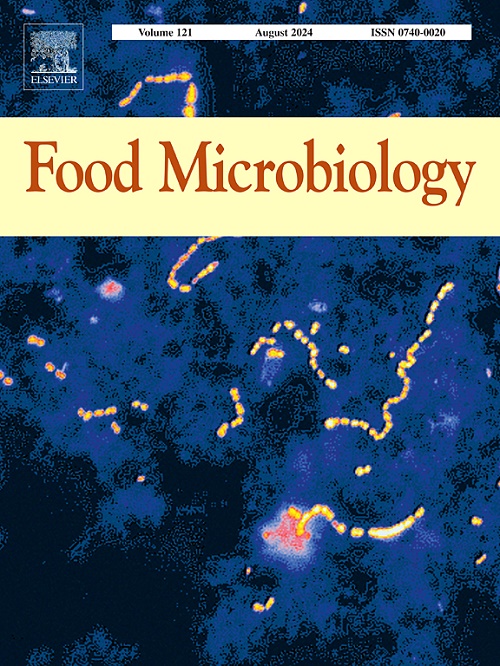Impact of kdcA, pdhD, and codY gene regulation in Lactococcus lactis 408 on 3-methylbutanal formation during cheddar cheese ripening
IF 4.5
1区 农林科学
Q1 BIOTECHNOLOGY & APPLIED MICROBIOLOGY
引用次数: 0
Abstract
3-Methylbutanal, a key volatile compound contributing to the nutty flavor of cheese, was primarily produced through the microbial catabolism of leucine. This study focused on the metabolic pathway of 3-methylbutanal at the genetic level during the ripening of Cheddar cheese. The influence of key genes (kdcA, pdhD, and codY) in Lactococcus lactis 408, a specifically selected adjunct culture, on the production of 3-methylbutanal was evaluated. Over a 14-day ripening period, a minor difference in leucine production was observed among different samples with adjunct culture, while alterations in the genes kdcA and pdhD, which were overexpressed in the strain, led to a decreased concentration of α-ketoisocaproate. Utilizing headspace solid-phase microextraction coupled with gas chromatography-flame ionization detection, a reduction was observed in 3-methylbutanal levels as ripening progressed. However, cheese fermented with the codY knockout strain displayed the highest level of 3-methylbutanal at both 0.5-day and 28-day ripening milestones. Further analysis using an Ag/AgCl electrode to assess the redox environment revealed that the higher redox potential in the codY knockout strain was instrumental in retaining elevated levels of 3-methylbutanal. These findings underscored the critical role of genetic factors in the flavor development of cheese and offered promising targets for enhancing flavor profiles in dairy products through biotechnological interventions.
乳酸乳球菌408中kdcA、pddd和codY基因调控对切达奶酪成熟过程中3-甲基丁醛形成的影响
3-甲基丁醛是一种重要的挥发性化合物,有助于奶酪的坚果味,主要是通过亮氨酸的微生物分解代谢产生的。本研究主要研究了3-甲基丁醛在切达奶酪成熟过程中的遗传代谢途径。研究了乳酸乳球菌408中关键基因(kdcA、pddd和codY)对3-甲基丁醛生产的影响。在14天的成熟期中,不同样品的亮氨酸产量略有差异,而菌株中过量表达的基因kdcA和pddd的改变导致α-酮异己酸盐浓度降低。利用顶空固相微萃取和气相色谱-火焰电离检测,观察到随着成熟的进行,3-甲基丁醛水平降低。然而,用codY敲除菌株发酵的奶酪在0.5天和28天的成熟里程碑上都显示出最高水平的3-甲基丁醛。使用Ag/AgCl电极评估氧化还原环境的进一步分析显示,codY敲除菌株中较高的氧化还原电位有助于保持高水平的3-甲基丁醛。这些发现强调了遗传因素在奶酪风味发展中的关键作用,并为通过生物技术干预提高乳制品风味特征提供了有希望的目标。
本文章由计算机程序翻译,如有差异,请以英文原文为准。
求助全文
约1分钟内获得全文
求助全文
来源期刊

Food microbiology
工程技术-生物工程与应用微生物
CiteScore
11.30
自引率
3.80%
发文量
179
审稿时长
44 days
期刊介绍:
Food Microbiology publishes original research articles, short communications, review papers, letters, news items and book reviews dealing with all aspects of the microbiology of foods. The editors aim to publish manuscripts of the highest quality which are both relevant and applicable to the broad field covered by the journal. Studies must be novel, have a clear connection to food microbiology, and be of general interest to the international community of food microbiologists. The editors make every effort to ensure rapid and fair reviews, resulting in timely publication of accepted manuscripts.
 求助内容:
求助内容: 应助结果提醒方式:
应助结果提醒方式:


